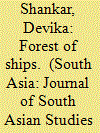|
|
|
Sort Order |
|
|
|
Items / Page
|
|
|
|
|
|
|
| Srl | Item |
| 1 |
ID:
190731


|
|
|
|
|
| Summary/Abstract |
This paper examines how the annexation of Malabar by the English East India Company in the last decade of the eighteenth century allowed the colonial administration to experiment with novel forms of state control in the region’s forests. At the same time, through a focus on the connections forged between Malabar’s forests and Bombay’s dockyards, this paper will use archival sources to examine the crucial role played by the timber monopoly introduced in 1806 in dislodging Malabar and its ports from their central position in the Indian Ocean economy and facilitating their incorporation into the margins of the emerging colonial economy.
|
|
|
|
|
|
|
|
|
|
|
|
|
|
|
|
| 2 |
ID:
120724


|
|
|
|
|
| Publication |
2013.
|
| Summary/Abstract |
In a world still dominated by a geopolitical system of territorial states, one tool in the state- and nation-building repertoire is the strategy of moving a capital from one city to another, and to an ostensibly more 'central' location of a geometrically conceived territory. From Ankara to Brasília, the technique has been used in a variety of places around the world, and Kazakhstan's new capital since 1997, Astana, is one more recent iteration. Taking a Foucauldian approach to analysing political technologies of government, the author examines the strategy of the centrally located city and considers how it has been instrumental to simultaneously producing a 'state effect' and a 'territory effect' in newly independent Kazakhstan. Part of a larger mixed-methods study, this article draws on a diverse range of methods, including data from interviews, participant observation, textual analysis, focus groups and a country-wide survey.
|
|
|
|
|
|
|
|
|
|
|
|
|
|
|
|
| 3 |
ID:
119143


|
|
|
|
|
| Publication |
2013.
|
| Summary/Abstract |
Few Indian regions evoke political, economic, and cultural marginalisation as much as North-East India. Solutions to its political instability often assume that, provided the vicious circle of under-development and violence can be broken, the region will eventually build a stable relationship with the Indian nation-state. This understanding in turns rests on a long intellectual genealogy that associates development with the state and the nation. By examining development schemes in the North-East Frontier Agency (NEFA, today's Arunachal Pradesh) in the 1950-1960s, a hitherto scarcely administered region where these were the primary mode of state-building, this article cautions against the tendency to see the Indian state's developmental ambitions as an instrument of nation-building. Instead it argues that, in North-East India at least, state-making and nation-building have not historically gone together, and that developmentalism played an important part in this rupture. On the ground, tribal development did little for NEFA's integration into the Indian nation. In fact, state-making processes resulted in the disintegration of the links that had tied NEFA with its regional hinterland in India. In the process, some of the seeds of tensions plaguing today's North-East India were planted.
|
|
|
|
|
|
|
|
|
|
|
|
|
|
|
|
|
|
|
|
|